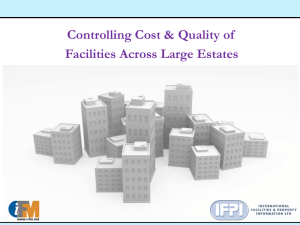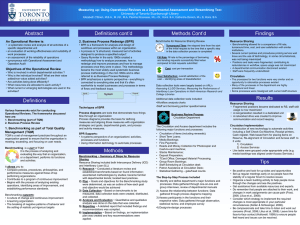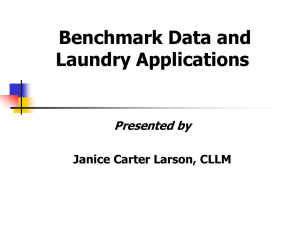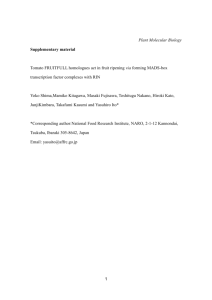Draft guidelines & explanatory statement
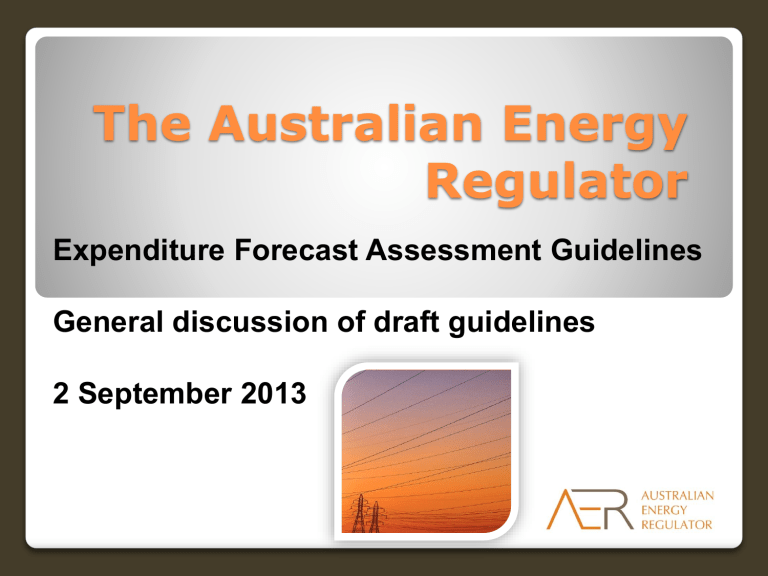
The Australian Energy
Regulator
Expenditure Forecast Assessment Guidelines
General discussion of draft guidelines
2 September 2013
Consultation up to the release of the final guideline
Date Subject
2 September General discussion of the draft guidelines
Release of draft economic benchmarking RIN Mid
September
20
September
Submissions on explanatory statement and guideline due
Late
September
Category analysis state by state workshops
Bilateral meetings / workshop on economic benchmarking data requirements
Mid October Submissions on draft economic benchmarking RIN due
November Economic benchmarking RIN issued
Final guideline and explanatory statement released
Draft category analysis RIN released
2
Context for today
Today we are looking to get your initial reactions on:
◦ the explanatory statement and guideline
◦ category analysis
◦ economic benchmarking
We will be gathering feedback in order to determine which areas to focus on in further consultation
Provide clarifications to inform stakeholder submissions
3
Agenda
9:30
11:00
General guideline design, assessment approach and implementation
10:15 Category analysis
Break
11:15 Economic benchmarking
12:00 Summary and next steps
4
Guideline design, assessment approach, and implementation
5
Purpose of the guideline: recap
Guidelines:
specify the approach that the AER proposes to use to assess opex and capex set out data requirements
Process:
1.
2.
At the F&A the AER decides on the application of the guideline to the NSP (data requirements)
NSP provides data with proposal
3.
The AER can depart from the F&A, but the AER must provide reasons
6
Guideline design (1)
Guideline sets out the AER’s assessment approach for opex and capex
◦ Plain language, rather than provisions
Assessment approach is very similar to current approach
Flexibility provided for AER to select best techniques or multiple techniques
7
Guideline design (2)
Principles are not in the guideline, but are set out in explanatory statement
The role of any particular technique has not been constrained
Data requirements set out in appendix to guideline, but ultimately will be collected in RINs
8
Assessment approach: Techniques
Benchmarking (economic, category)
Methodology review
Governance and policy review
Trend analysis
Cost-benefit analysis
Detailed project review
9
Assessment approach: Principles
Accuracy and reliability
Robustness
Transparency
Parsimony
Fitness for purpose
10
Assessment approach: Opex (1)
Base step trend model
Revealed costs for the base, unless we identify material inefficiencies
All techniques used to assess base
11
Assessment approach: Opex (2)
Rate of change (output growth, real price growth, productivity growth, step changes)
Ideally, productivity growth will be estimated using economic benchmarking
12
Assessment approach: Capex (1)
All techniques applied, but will primarily review category by driver (unit cost and volume)
Will be applying augex and repex models, but may need to supplement with other techniques
13
Implementation(1)
•
•
•
Guideline and explanatory statement in place by 29 November
Final RINs
• Economic benchmarking — Oct / Nov 2013
• Category — Feb 2014
• Reset — Feb 2014
2014 annual benchmarking report
• Economic benchmarking
• Category analysis
14
Implementation: RINs(2)
•
•
•
•
2014:
Economic benchmarking RIN
Category analysis RIN
Reset RIN (if relevant)
Annual reporting RIN
•
•
In 2015, we will transition to:
Annual reporting RIO
Reset RIN
15
Category analysis
16
Key elements of approach
Driver/ activity based, consistent with previous reviews
Much more data than requested before
◦ Visibility of historic and forecast work rates/ volumes for each activity
◦ Comparisons of cost per “unit” – trend and benchmarking comparisons
◦ Capturing of material cost drivers and
“uncontrollable” environmental factors
17
Points for discussion
Level of detail
◦ Labour, materials, contract, other
◦ Balance between accurate, like for like comparisons vs high level/ reasonableness checks
Capture of NSP idiosyncrasies
Impact of service classifications
◦ Inclusion of metering, public lighting, ACS
Ability of NSPs to provide reliable, useful backcast data
18
Points for discussion (cont)
Separation of direct/ indirect costs
Addressing differences in allocations and capitalisation
◦ Scope for data requirements outside of guidelines eg reconciliation to statutory accounts
Issues for targeted consultation
◦ Developing robust definitions - worked examples may be useful
◦ Feasibility/ timing issues for NSPs
◦ Consistency with economic benchmarking data
19
Economic benchmarking
20
Model specification: DNSPs (1)
Output specifications 1 and 2:
◦ Customers
◦ Capacity (kVA * Kms) [or smoothed maximum demand]
◦ Interruptions
Output specification 2
◦ Residential customers
◦ Commercial customers
◦ Small industrial
◦ Large industrial
◦ Interruptions
21
Model specification: DNSPs (2)
Environmental variables
◦ Density — Customer density, Energy density,
Demand density
◦ Weather factors — Extreme heat days, Extreme cold days, Extreme wind days
◦ Terrain factors — Bushfire risk, Rural proportion, Vegetation growth and encroachment, Standard vehicle access
◦ Service area factor — Line length
22
Model specification: TNSPs (1)
Output specification 1:
◦ System capacity (kVA*kms)
◦ Entry and exit points
◦ Loss of supply events
◦ Aggregate unplanned outage duration
Output specification 2:
◦ Smoothed non-coincident maximum demand
(as a capacity measure)
◦ Energy delivered could be incorporated into either specification
23
Model specification: TNSPs (2)
Environmental variables:
◦ Weather factors — Extreme heat days, Extreme cold days, Extreme wind days, Average wind speed
◦ Terrain factors — Bushfire risk, Rural proportion, Vegetation growth and encroachment, Standard vehicle access,
Altitude
◦ Network characteristics — Line length,
Variability of dispatch, Concentrated load distance
24
Model specification: Inputs
Input specifications
◦ Nominal opex (deflated by average price index)
◦ Overhead lines (MVA-kms)
◦ Underground lines (MVA-kms)
◦ Transformers and other (MVA)
Alternative capital inputs based on nominal RAB deflated by a price index will be looked at as well
25
Applications
Models
◦ MTFP, DEA (cross sectional, time series)
◦ Econometric opex model
Applications as set out in models (6 June workshop)
◦ Overall NSP efficiency, frontier
◦ Diagnosing sources of inefficiency
◦ Top down opex forecast, rate of change
26
Next steps (1)
Draft RIN
Consultation on draft RIN
◦ Would another workshop on data be helpful?
27
Next steps (2)
Economic Insights
◦ Engaged to conduct testing and validation exercise for benchmarking models in 2014
◦ To commence in February
◦ Will initially review robustness of data, liaise with NSPs
◦ Model and report to be provided to stakeholders
28
Summary and next steps
29


